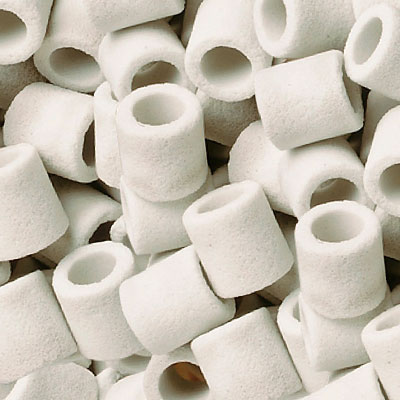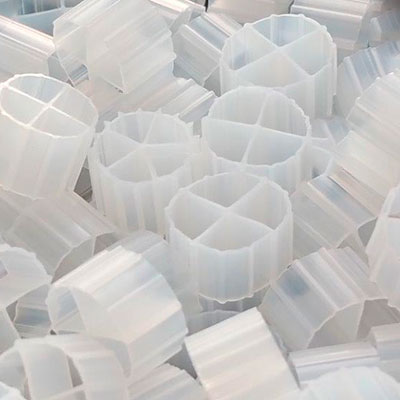How To Clean Up Ziss Biological Filter
It's alive….
Your filter, that is.
And as yous will before long learn, that's a expert thing!
A live filter is referred to every bit biological filtration, and it tin can make all the difference to the water quality in your aquarium.
Today, I am going to teach you everything you need to know near biological filtration.
What is biological filtration?
Biological filtration is one of three different types of filters that can be used in your aquarium. The other two are mechanical and chemical filtration.
Different the other filters, biological filtration uses living organisms to remove nasty substances from your aquarium.
Only not just any living organism…
Bacteria!
If you are a germophobe, and so simply the very sight of that give-and-take will transport shivers downward your spine.
But the bacteria used in biological filtration are your friends. If you want to successfully enhance happy and salubrious fish, you need these leaner in your tank.
Fishlab Fact: Any filter media that is designed to provide a home to the bacteria used in biological filtration is referred to as a bio filter.
Biological filtration works a niggling differently from the other methods of filtration. Mechanical and chemical filtration work by removing the unwanted stuff.
But that'southward not how biological filtration works… Instead, it converts i chemical to another.
Now this may audio confusing, but it's really very simple.
Recall back to the nitrogen cycle for a moment. Waste material, such as fish poop or uneaten food, breaks down and releases ammonia.
Leaner then eat the ammonia and convert it to
And then, another type of leaner converts nitrite to nitrate.

This is biological filtration at work.
Biological filtration refers to when bacteria in your tank consume any chemical compound, such as ammonia, nitrite or nitrate, and and so convert it into something else.
You want these leaner in your aquarium. That'southward why they are commonly referred to as beneficial bacteria!
With enough benign leaner in your aquarium, they will swallow ammonia and nitrite as apace as it is produced.
What types of bacteria are used in biological filtration?
In that location are 2 different categories of bacteria used in biological filtration: nitrifying bacteria and denitrifying bacteria.
1. Nitrifying bacteria
Bacteria that remove ammonia and nitrite from the water
Nitrifying bacteria require a source of oxygen, using it to convert ammonia to nitrite and nitrite to nitrate.
The bacteria tin be found on all different surfaces of your aquarium, just where it truly benefits your tank is in your filter media, where it removes ammonia and nitrite from your aquarium as it passes through your filter.
Nitrosomonas – Eat ammonia, converting it to nitrite.
Nitrospira and Nitrobacter – Eat nitrite, converting it to nitrate.
Nitrifying bacteria work together as a squad, with one bacteria providing a food source for the next.
A new aquarium doesn't have enough of these bacteria present to efficiently filter the nasties from your aquarium.
This is the precise reason why y'all cycle your tank.
During the cycling process you wait for these bacteria to grow in number. Once an established colony of bacteria forms, they will be able to eat ammonia and nitrites every bit quickly every bit they are produced.
And in one case this happens, you tin consider your new tank completely cycled.
FishLab Fact: Because biological filtration uses living organisms, intendance must be taken when cleaning your filter. Using chemical cleaning products or fifty-fifty tap h2o can impale the bacteria – throwing the nitrogen bicycle out of residue and causing chaos in your aquarium.
Nitrifying leaner abound best on filter media with a large surface area, including…
- Bio assurance
- Filter floss
- Sponges
- Ceramic noodles
2. Denitrifying bacteria
Bacteria that remove nitrates from the h2o
Denitrifying bacteria be where in that location is no oxygen nowadays.
The reason for this is when oxygen is present in water, the bacteria use it to breathe. But without oxygen, these bacteria apply nitrates instead, converting them into nitrogen gas[one].
The nitrogen gas then exits your aquarium through the surface water.
Considering of this, denitrifying bacteria just be in areas of your aquarium that are not oxygenated, such as inside rocks.
Filter media that is suitable for denitrifying leaner include:
- Volcanic rock
- Ceramic noodles
For freshwater tanks, denitrifying bacteria volition exist the to the lowest degree of import blazon of biological filtration in your aquarium – nearly people skip over information technology completely.
The reason for this is that nitrates are non as harmful to your fish as ammonia or nitrites. And to tiptop it off, nitrates are removed from your aquarium when yous perform a water modify.
And considering a water change has other benefits, including returning essential minerals to your aquarium, a h2o modify is considered a good substitute to using denitrifying bacteria equally biological filtration.
Saltwater tanks are the exception to this. Marine fish, invertebrates and corals all have a low nitrate tolerance – denitryfying bacteria are commonly used to aid in removing nitrates from saltwater tanks.
What is the best biological filter?
Given the correct surroundings, nitrifying bacteria can grow nigh anywhere – even in the filter pad in your HOB filter.
Just if you lot want to achieve the all-time biological filtration possible, and then you want to use a filter media designed for housing bacteria.
And to do that, it's all about the surface area.
Did y'all know? When discussed online, "biological filtration media" is often shortened to bio media.
You lot see, the more surface there is for bacteria to cling to, the more than biological filtration you can achieve.
Think the filter media as a house. A single bedroom flat won't fit as many people inside information technology as a mansion.
Filter media designed for biological filtration is essentially a mansion for beneficial bacteria.
Let's have a closer look at some of the all-time and about popular bio filters effectually.
Ceramic rings

Suitable for both nitrifying and denitrifying leaner
It's no secret that my personal favorite biological filter media is Siporax. Fabricated in Germany, this may look like whatsoever other ceramic band, but information technology's really fabricated from a sintered glass.
I have had these in my aquarium for a year and a one-half at present – I just give them a rinse every 6 months at the aforementioned time I perform a water change. Just make certain to rinse them in tank h2o!
Ceramic balls

Suitable for both nitrifying and denitrifying bacteria
Ceramic is another popular biological filter media, and one of the all-time comes from MarinePure. Proof that big things come in small-scale packages, each ceramic sphere can comprise up to 240 square feet of area!
Bio balls

Suitable only for nitrifying bacteria
Bio balls are a plastic bio media that oftentimes gets a bad rap. However, they are more than capable of providing biological filtration without issues when used correctly.
The key to success with bio balls is having a mechanical pre-filter so that waste product does not become stuck in the holes of this media.
Moving bed filter media

Suitable simply for nitrifying bacteria
Final but not least, I want to bear upon a bio media made for a specific blazon of filter – the moving bed filter.
Yous may have noticed that these pieces of media have a rather small-scale surface expanse when compared to the other media I discussed.
That's because each piece of filter media is constantly moving, crashing into one another. The idea is that just the strongest bacteria can cling to the surface and filter your tank. Whatever dead bacteria falls off, allowing alive bacteria to have its place.
Conclusion
When used correctly, biological filtration is a major contributor to the wellness of your aquarium.
Just remember that bio media is essentially a living creature and can dice if not cared for. When cleaning your bio media, only rinse it in tank water – using tap water can kill the practiced bacteria due to the chlorine content.
Practice y'all utilise biological filtration in your aquarium? Accept something to add? Allow me know in the comments below!
How To Clean Up Ziss Biological Filter,
Source: https://fishlab.com/biological-filtration/
Posted by: louisterew1970.blogspot.com


0 Response to "How To Clean Up Ziss Biological Filter"
Post a Comment